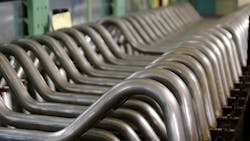The two most common types of metal tubing used in custom tube bending and tube lasering are seamless and welded. The choice between the two is normally determined by application type, material availability and cost. Since welded tubing is more readily available and sometimes more economical than seamless tubing, many manufacturers specify this type of material for their projects.
Because the weld seam impacts the structural and physical properties of the tube, many fabricators use equipment with some form of weld seam detection, a technology that identifies the location of the weld seam on the tube so that it can be correctly placed in the machine prior to tube bending or tube laser cutting. This can be done either using sensors or manually and is quite important to figure into the overall process to achieve a quality result.
For tube bending, the weld seam must be oriented to the neutral, or zero, axis (top or bottom relative to bend plane) so that it is not exposed to stretching or contracting. For tight bends, this is especially critical as bending on a tight radius requires more torque, which can cause cracks along the seam. In some cases, where a seam would interfere with the aesthetics of the final product, the weld seam location will be called out in the drawing file or communicated to the fabricator.
The standard rule of thumb for tube bending is to position the weld seam at the top or bottom of the material, close to the zero axis.
In fiber optic tube laser cutting, weld seam detection is typically integrated with the machine, which uses a camera or sensor to identify the weld location. The machine then rotates the tube so that cuts are made (away from the seam) in the correct place on the material. When laser cutting tubing, you want to stay away from the weld seam whenever possible.
Because not all stock material is created the same, operators must take care to check for consistency of the seam in each batch prior to loading the tubes for lasering or bending. On occasion, there can be inconsistency between batches and material must be checked to verify that the seam is in the same place for each of the tubes.
For both tube bending the tube laser cutting, it is important that the weld seam is correctly oriented at the start of the job. This allows the operator to run accurate, consistent batches without intervening, helping to streamline production and to stay focused on the overall quality of the work.
Marshall Arndt is a manufacturing engineer at Sharpe Products.
